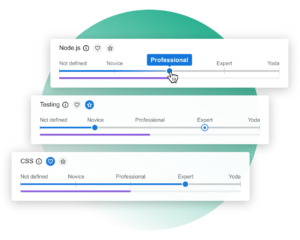Competency model
Learn what a competency model is. Discover its benefits and examples. Learn seven best practices for developing an effective model for your organization.

Discover:
- What is a competency model?
- What are the benefits of using a competency model?
- The types of competencies that make up the model
- How are competency models used?
- What is an example of a competency?
- How to develop effective competency models
What is a competency model?
A competency model is a guideline developed by a Human Resource department that sets out the specific skills, knowledge and behavioral requirements that enable an employee to perform their job successfully.
Competency models define what performance success should look like within the organization for each individual job. The model is applied to recruitment practices, talent management, training and performance assessment.

What is the difference between a job description and a competency model?
A job description and a competency model sound almost alike because they both seem to describe what an employee is required to do in the job. What is the difference?
The difference is that a job description is a general summary of the skills required for a job, whereas a competency model provides specific behaviors that an employee must do on the job in order to be successful.
What are the benefits of using a competency model?
Greater performance success has been attributed to organizations with thoroughly defined competency models. In a competency survey by the Society for Human Resource Management (SHRM), 93% of 500 C-suite executives claimed that competency models were important to their organization’s performance success.
Here are some of the ways that implementing the competency model benefits organizations:
- Sets a concrete direction for workforce performance that aligns with organizational goals and strategies.
- Enables HR to have a concrete understanding of all employee abilities and skills.
- Enables HR and Training to more accurately identify learning & development (L&D) needs.
- Allows employees to take ownership of the skills and behaviors required of them in their roles.
- Empowers organizations to keep track of what skills employees have so that strategy and planning can work towards that future skills may be needed.
- Provides a consistent and fair system of measurement for performance evaluation.

How to conduct a skills gap analysis and what to do next
Start building your foundation for strategic workforce development.
Download guideThe types of competencies that make up the model
There is no standard list of competencies for any given job. The type of competency that feeds into a competency model depends on the specific needs of the job. For example, the competencies listed for a restaurant waiter will differ drastically from the needs of an accountant.
Competencies can be broken down into helpful categories to better understand the type of information that might be included, such as:
1. Core competencies
Core competencies include the baseline skills required by the organization for all employees; these are the basic things that employees must fulfill. This will vary from company to company, as it depends on the values, philosophy and goals of each organization, but can include basic requirements like communication skills or teamwork. Most jobs require a basic element of being able to work with other people to some degree.
The goals of the organization are reflected in broad competencies that reflect the strength and uniqueness of the organization. For a company that specializes in international parcel delivery, the core competency would be logistics. Drilling down to an employee’s job within this type of organization, a core competency for an employee could be on-time delivery of customer parcels.
2. Functional competencies
Functional competencies are job-specific skills and behaviors that are unique for each role. For example, a competency for a restaurant waiter may be the ability to effectively handle customer complaints, where a competency for an accountant may be the ability to analyze a specific type of financial data in order to prepare reports.
Functional competencies should describe what behaviors or skills need to be performed in order for the employee to be a top-performer in their position.
3. Leadership competencies
Leadership competencies are often used for supervisory and management related roles, although can be applied to any job position that requires an employee to lead others. They include leadership skills and behaviors like decision-making abilities.

Connecting skills and learning
Valamis provides you with skills management and learning tools in the same platform, allowing you to tailor your content to existing needs.
Learn moreHow are competency models used?
Competency models are used for a variety of HR practices, including:
Recruitment – Fully developed competency models are often used for the development of job postings. When they are well-defined and clear, organizations have a better chance of finding more closely matched candidates.
Talent/Performance management – Defining what success should look like within the organization boils down to the performance of the workforce; a competency model can define what performance success should look like for each role within an organization. This benchmark helps HR to connect the function of each job with organizational goals and also ensure that the talent of employees is developed.
Performance appraisal – Competency models provide the framework needed to properly assess employees during a performance review; both the employee and employer have a clearly defined list of behaviors and skills to work from.
What is an example of a competency?
The format of a competency model for any given job will be different depending on the specific organization and profession. There is no standardization or required structure. Often, organizations will have their own unique templated format for competency models.
The Society for Human Resource Management (SHRM) offers a best practice in the formulation of competencies by breaking down what information should ideally be included in a specific competency:
Best Practice:
- Title – Name of the competency
- Definition – Overall definition of the competency
- Sub-competencies – General baseline skills and behaviors required
- Behaviors – Behaviours that reflect the highest level of proficiency
- Proficiency Standards – Skill standards that reflect job-specific requirements and reflect four stages of career development (early, mid-level, senior, executive)
Competency example:
- Title: Develop customer relationships
- Definition: As part of the Sales process, the ability to create a lasting relationship with customers via interactions is integral to the role.
- Sub-competencies: Ability to communicate effectively with customers
- Behaviors: Emotional intelligence
- Proficiency Standards: Identify customer concerns and present methods for addressing concerns.
How to develop effective competency models
1. Determine what kind of process works for your organization
The research and development involved in creating well-defined competencies for a position can be lengthy; it takes time to understand what is needed for each position. Due to today’s fast-paced and ever-changing business environment, it could be beneficial for some organizations to have a shorter and more intensive method of development. Competency models that are also designed as flexible can likewise accommodate future changes.
2. Research available competency information
Developing competencies requires more than vague statements about what the job position will entail. As well, the functional competencies need to reflect what “great” performance should be, not just the baseline skills for “acceptable” performance.
Previously developed competencies for similar roles should be identified and used as a guideline, as well as related role documentation, background information and organizational core competencies.
3. Interview relevant business units and executives
Interviews with relevant stakeholders provide the insight needed for the role’s required competencies. Executives can provide the key organizational core competencies needed for the role that reflect both the values, philosophy and goals of the organization. Managers and high-performers from relevant business departments can be interviewed to find out the key skills and behaviors that are necessary and successful for those roles. When interviewing, the focus should be on what skills and behaviors make for a top-performing employee in that role.
4. Establish the core competencies
The core competencies should reflect the baseline behaviors and skills required by the organization. How should employees act and contribute as part of the organization so that they can integrate into the company’s work culture and philosophy? Utilize the research and interview content from executives and relevant organizational stakeholders.
5. Establish job-specific competencies
Job-specific competencies should reflect the unique role skills and behaviors as outlined by departmental managers and top-performers at the research stage. What did these individuals need to know and do to perform well in their role?
6. Establish leadership competencies, where needed
When management-related competencies need to be drafted, it should be assumed that the individuals are already familiar with the core competencies set out by the organization. The focus should be on unique leadership attributes and skills. These can be determined by the executive and senior management level at the research stage.
7. Finalize the competency list
Organize the findings, but avoid being unrealistic with narrowing down competencies. If the list is too far-fetched, it could hinder recruitment initiatives and scare away potential applicants. If the list is too vague or not specific-enough, it could result in an influx of candidates that are not perfectly suited to the position; it will also not help employees to achieve organizational goals.
Validate the competency list with all stakeholders involved in the process, including executives and management. Signing off on competencies is important to ensure that that all levels of the organization’s needs are being met.




